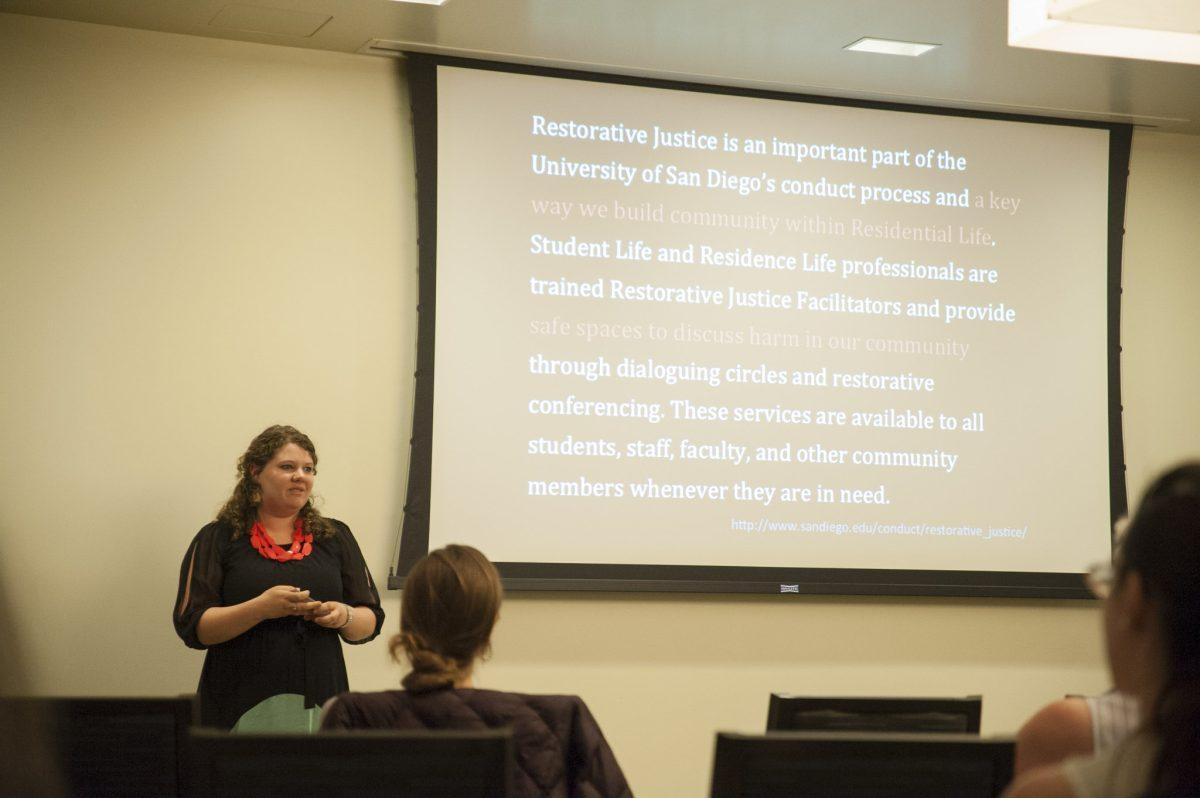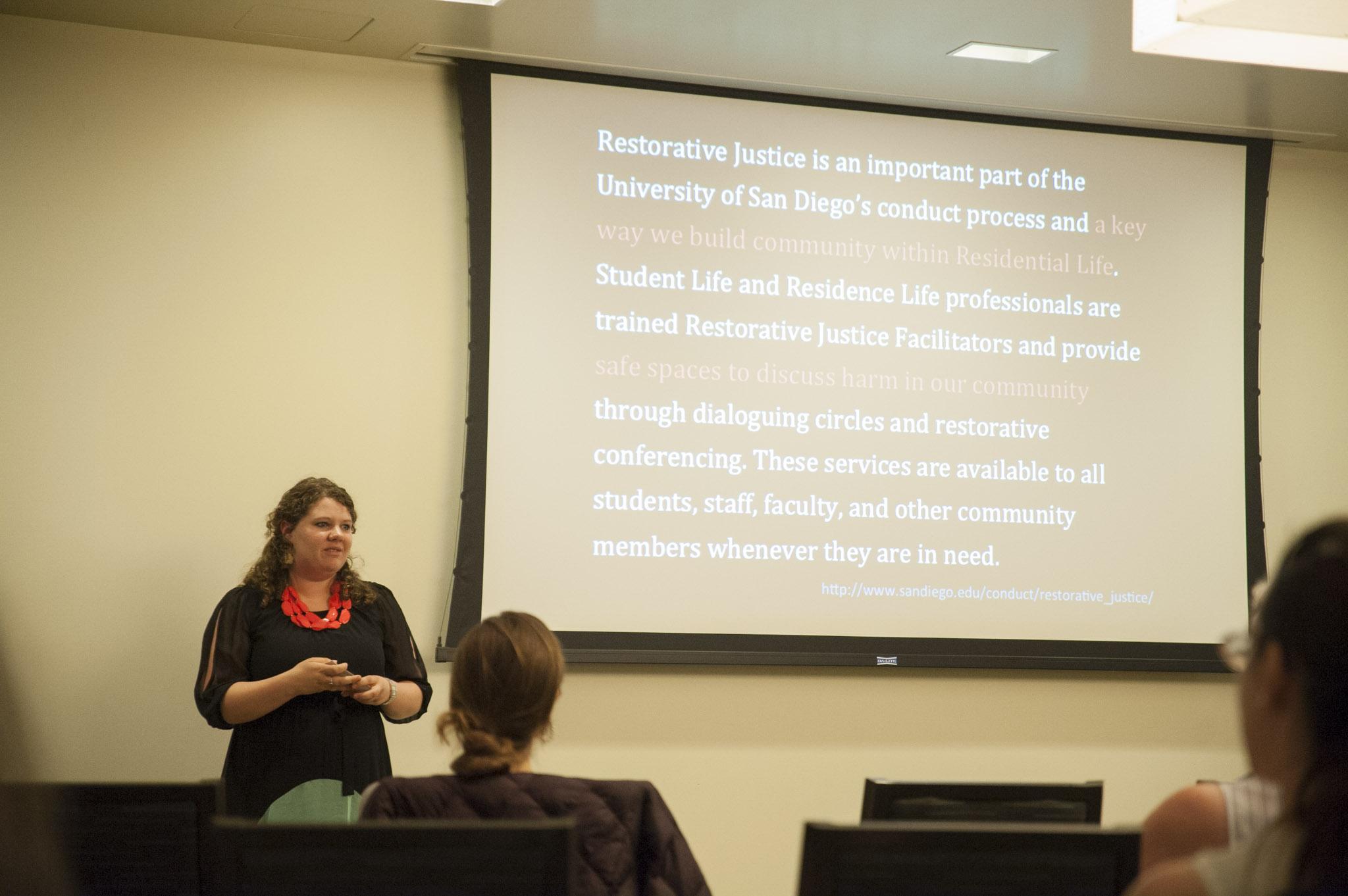A psychology course is spawning a wave of support for the implementation of Restorative Justice at Sonoma State University.
Partnering with Restorative Resources of Santa Rosa, two students from psychology professor Maria Hess’s Intro to Community Mental Health class, Lauren Dillier and Cody Hoffman-Brown, presented their research concerning the topic at an open-forum presentation on Wednesday, April 23. At the forum presentation, held in the Bennett Valley room of the Student Center, Dillier and Hoffman-Brown voiced their hope for its application throughout the Sonoma State community in the future.
Restorative Justice can be defined as a community based approach on how to deal with crime, the effects of crime and the prevention of crime. The approach is something that functions on the belief that the path to justice relies on problem solving and healing rather than punishment and isolation.
“[Hess] was looking for a way to engage her students with community organizations, and we [Restorative Resources] agreed to do an introductory training with her class and take on five students for a semester-long service learning project,” said Jessica Hankins, volunteer coordinator and adult program coordinator for Restorative Resources.
“There, the idea was born that we could explore bringing Restorative Justice to Sonoma State, and Maria approved this [task] for [Dillier and Hoffman-Brown]. From there, the three of us met several times throughout the semester, identifying stakeholders on campus, generating interest on the subject and planning our presentation”
“I will admit that, at first, I was a little skeptical about seeing how [Restorative Justice] would all work,” said Dillier, psychology major and Community Services Advisor. “But in our first meeting with Restorative Resources, we did a role-play activity where one [person] played a victim, another played an offender and a third was the mediator. Through this simulated process, I could see the healing that happened with both the victim and the offender.”
Instead of simply punishing a perpetrator for a crime, the restorative justice model strives to bring reparation and resolution to all, in the form of a facilitated circle wherein the victim, offender and others affected are all brought together to discuss the circumstances and motivations behind the crime as well as a fitting way for the offender to make amends.
“Victims are given the opportunity to be heard and share what they need to move on. Offenders are given the chance to hear how their actions have affected others, and because of this, are less likely to repeat their offense in the future,” said Hankins. “Restorative Justice is also a good idea because it teaches everyone involved how to communicate better and strengthens community by involving everybody at an equal level. Instead of pushing people out when they have made a mistake, it brings them back in and reminds them that they have a place in their community, just like everyone else.”
If Sonoma State were to take on these practices, the university would be following in the footsteps of several other colleges and universities across the nation, including University of Colorado, Boulder (the first to do so), Skidmore College, University of Michigan and University of San Diego. One of the members of the group that implemented Restorative Justice process at the University of Colorado, Boulder was Matthew Lopez-Phillips, vice president for student affairs and chief student affairs officer at Sonoma State.
“We had amazing results with the program, and the community enjoyed being a part of the process as well,” said Lopez-Phillips. “SSU could benefit from such a program as it brings the larger community together to address issues of harm. Repairing that harm is the cornerstone of Restorative Justice circles. It would be great to see a RJ program on campus.”
The event, which Dillier, Hoffman-Brown and Hankins said is the first of many, drew a crowd of about 20 people, ranging from a few students, to faculty, to Sonoma State Chief of Police Nathan Johnson, all of whom voiced their support for a Restorative Justice program at Sonoma State University.
“Exactly where it would be situated, what kinds of issues would be brought to it, who would actually do it, etc., is unclear at this point,” said Pat Jackson, professor of criminology and criminal justice studies. “My sense of our purpose now is to involve key persons and groups at SSU and the surrounding community to consider the idea and how it might work.”
Some program requirements/necessities discussed at the event were the implementation of an on-site paid coordinator, and a designated space for Restorative Justice conferences (circles) and volunteers. So far, ideas of how to fund the program have spanned from the offender paying a fee, to the student body paying a small fee ($5 or less) as part of tuition, or the use of grants and off-campus funding.
“We’re working on scheduling some time to sit down with Matthew Lopez-Phillips as well as the chiefs’ of Police for our campus, Rohnert Park and Cotati to discuss how we can advance or outline a restorative program for both the campus and local community,” said Hoffman-Brown.
“We are also looking to talk to Associated Students and the school of education,” said Dillier. “We do plan to try and continue these types of conversations over summer and see where things can go.”
For more information on Restorative Justice, visit the Restorative Resources website, and for news on the latest in the push to implement Restorative Justice at Sonoma State, contact Dillier or Hoffman-Brown.





![[Both photos courtesy of sonoma.edu]
Ming-Ting Mike Lee stepped in as the new SSU president following Sakakis resignation in July 2022](https://sonomastatestar.com/wp-content/uploads/2024/04/CC4520AB-22A7-41B2-9F6F-2A2D5F76A28C-1200x1200.jpeg)



























